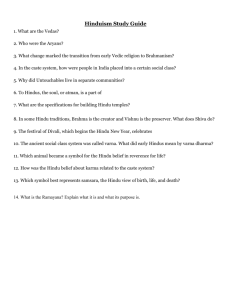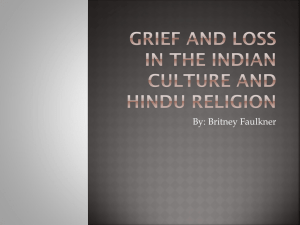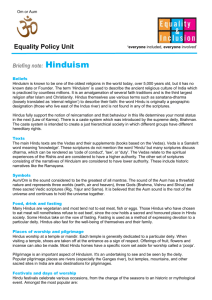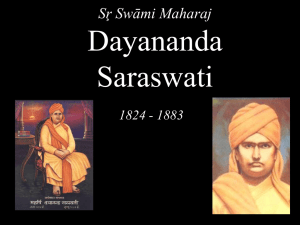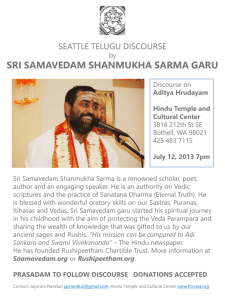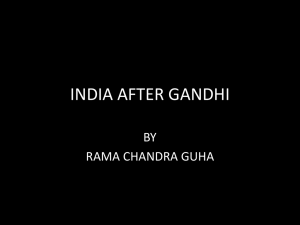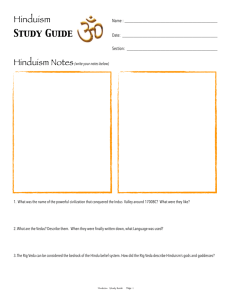Chapter 8 The Richness of the Hindu Tradition By Dr. Tim Callaway
advertisement
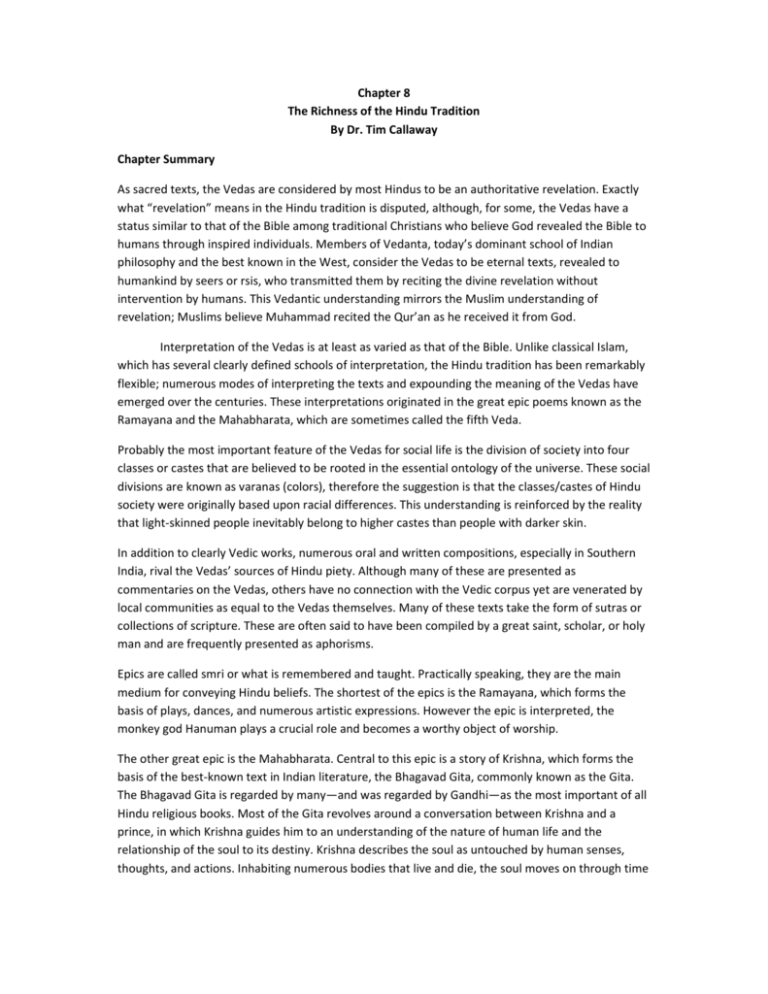
Chapter 8 The Richness of the Hindu Tradition By Dr. Tim Callaway Chapter Summary As sacred texts, the Vedas are considered by most Hindus to be an authoritative revelation. Exactly what “revelation” means in the Hindu tradition is disputed, although, for some, the Vedas have a status similar to that of the Bible among traditional Christians who believe God revealed the Bible to humans through inspired individuals. Members of Vedanta, today’s dominant school of Indian philosophy and the best known in the West, consider the Vedas to be eternal texts, revealed to humankind by seers or rsis, who transmitted them by reciting the divine revelation without intervention by humans. This Vedantic understanding mirrors the Muslim understanding of revelation; Muslims believe Muhammad recited the Qur’an as he received it from God. Interpretation of the Vedas is at least as varied as that of the Bible. Unlike classical Islam, which has several clearly defined schools of interpretation, the Hindu tradition has been remarkably flexible; numerous modes of interpreting the texts and expounding the meaning of the Vedas have emerged over the centuries. These interpretations originated in the great epic poems known as the Ramayana and the Mahabharata, which are sometimes called the fifth Veda. Probably the most important feature of the Vedas for social life is the division of society into four classes or castes that are believed to be rooted in the essential ontology of the universe. These social divisions are known as varanas (colors), therefore the suggestion is that the classes/castes of Hindu society were originally based upon racial differences. This understanding is reinforced by the reality that light‐skinned people inevitably belong to higher castes than people with darker skin. In addition to clearly Vedic works, numerous oral and written compositions, especially in Southern India, rival the Vedas’ sources of Hindu piety. Although many of these are presented as commentaries on the Vedas, others have no connection with the Vedic corpus yet are venerated by local communities as equal to the Vedas themselves. Many of these texts take the form of sutras or collections of scripture. These are often said to have been compiled by a great saint, scholar, or holy man and are frequently presented as aphorisms. Epics are called smri or what is remembered and taught. Practically speaking, they are the main medium for conveying Hindu beliefs. The shortest of the epics is the Ramayana, which forms the basis of plays, dances, and numerous artistic expressions. However the epic is interpreted, the monkey god Hanuman plays a crucial role and becomes a worthy object of worship. The other great epic is the Mahabharata. Central to this epic is a story of Krishna, which forms the basis of the best‐known text in Indian literature, the Bhagavad Gita, commonly known as the Gita. The Bhagavad Gita is regarded by many—and was regarded by Gandhi—as the most important of all Hindu religious books. Most of the Gita revolves around a conversation between Krishna and a prince, in which Krishna guides him to an understanding of the nature of human life and the relationship of the soul to its destiny. Krishna describes the soul as untouched by human senses, thoughts, and actions. Inhabiting numerous bodies that live and die, the soul moves on through time until eventually it is liberated from the vicious cycle of birth and death by which it is bound to the wheel of samsara. In the Hindu tradition, samsara is pictured as the ever‐turning wheel of time to which all living things are bound by karma. Karma is the belief that all things are embraced by a universal law of cause and effect that stretches through time, binding living beings to the wheel of samsara. Consequently, the soul never dies, though numerous bodies die. Through the Gita, Hindu monotheism develops from abstract principles and the theoretical identification of individual gods with the one God into an intensely personal form of devotion. The one cosmic being is now identified with a highly personal God who takes an intimate interest in each individual soul. Yet, unlike the attitude of the God that Christians worship, this interest in the individual is an interest in the eternal soul, not a particular person. Although most Hindus claim the Vedas are the source of their religious beliefs and practices, Ramayan and Mahabharata form the practical basis of most Hindu religious life. From the reading of these epics, and their presentation in film, plays, and TV, Hindus gain entry to the rich mythology and religious teachings of their tradition. The Puranas represent the popular expression of Hindu piety. There are eighteen major Puranas and eighteen minor ones, all of which claim to expound the Vedas. They are devoted to the virtues of a particular god. For example, the Vishnu Parana is written in praise of the god Vishnu, who is identified with Brahman, the power or force which encompasses the whole universe (not to be confused with the god Brahma or the class of Hindu holy men known as Brahmin). All the Puranas teach a similar doctrine of creation and destruction based on a cyclic view of time. The Yoga Sutras of Patanjali provide a systematic interpretation of the practice of Yoga. Here, Yoga is defined as the “mastery or suppression of the mind.” Its goal is to attain a pure state of consciousness without any of life’s normal distractions. Yoga develops out of the Upanishads which are the interpretive texts that explain the meaning of all other Hindu literature. The Upanishads contain conversations that expand Vedic teaching and give the Vedas their true interpretation. The distinguishing feature of the Upanishads is the quest for truth and philosophical knowledge. At the top of the Hindu hierarchy of gods is a trinity of beings—Brahma, Vishnu and Shiva—all of whom are accompanied by their female partners. Together, these pairs of leading gods represent the vital forces of creation known as shakti, sakti, or divine power. The gods are capable of taking many different forms. The Hindu tradition is highly philosophical and deeply devotional. Hindu piety begins in the home where space is devoted to a shrine featuring images of the gods of the household. The offering of food, drink, and devotion to these images is known as puja. Ritual cleansing plays an important part in Hindu tradition where washing and bathing are valued. Before prayer can be offered or sacred words chanted, good Hindus will wash their mouths. When a devout Hindu nears death they ought to be given a sip of water from the Ganges River. Many Hindus are vegetarian whereas others do eat poultry or fish. Hindu celebrations vary from area to area, caste to caste, and family to family. Certain major festivals have become common events within Hindu diaspora communities. The most popular of these is Diwali, or the Festival of Lights, which is celebrated in the fall with lanterns and fireworks. The first major translation of a Hindu text into English or any European language was undertaken by Charles Wilkins (1749–1836). The arrival of Indian immigrants in recent decades in Europe and North America led to the building of Hindu temples and the creation of a network of religious organizations, the most famous of which is the Hare Krishna movement.
